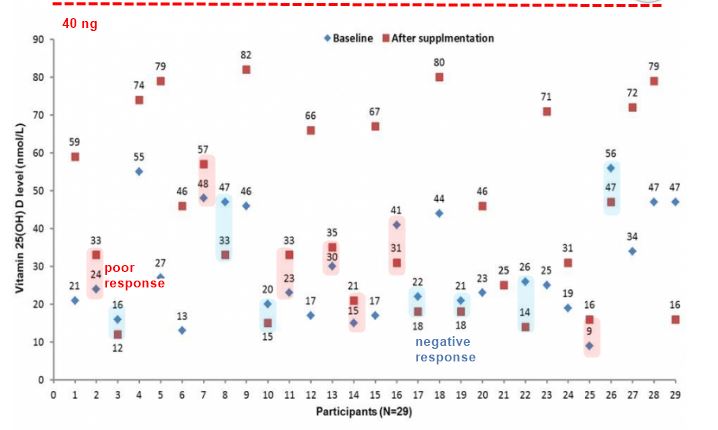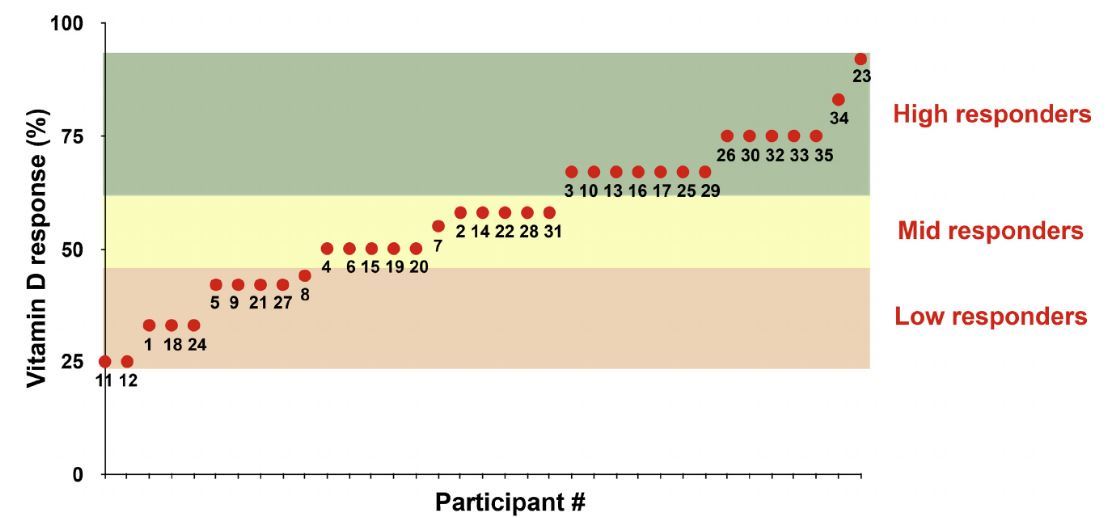Vitamin D injection helped migrants a bit, but some had poor or even negative responses
Serum 25-hydroxyvitamin D levels and intramuscular vitamin D3 supplementation among Eritrean migrants recently arrived in Switzerland
Swiss Med Wkly. 2017;147:w14568 DOI: https://doi.org/10.4414/smw.2017.14568
Afona Chernet, Nicole-Probst Hensch, Kerstin Kling, Véronique Sydow, Christosph Hatz, Daniel H Paris, Katharina Rentsch, Beatrice Nickel, Andreas Neumayr, Niklaus D Labhardt
Blue highlight = negative response Pink highlight = poor response

Note: 2nd measurement was at 12 weeks, Average BMI = 20 (not obese)
 * Note: some had poor responses, but none had negative responses
* 78 percent of pregnant immigrants in Sweden had less than 10 ng low vitamin D – Nov 2013
* Immigrants and refugees had lower vitamin D levels – Jan 2013
* Immigrant vitamin D deficiency in Europe – May 2011
* Overview Vitamin D Dose-Response includes many graphs, such as the following
*
* Note: some had poor responses, but none had negative responses
* 78 percent of pregnant immigrants in Sweden had less than 10 ng low vitamin D – Nov 2013
* Immigrants and refugees had lower vitamin D levels – Jan 2013
* Immigrant vitamin D deficiency in Europe – May 2011
* Overview Vitamin D Dose-Response includes many graphs, such as the following
*  * Note that virtually all had a good response fo a large dose
* Vitamin D injection lasts longer and has bigger response than weekly oral – Jan 2017
* * Injection category listing has items along with related searches**
* Vitamin D injection of 600,000 IU (response by 10 individuals)– Sept 2017(has the following chart
_
* Note that virtually all had a good response fo a large dose
* Vitamin D injection lasts longer and has bigger response than weekly oral – Jan 2017
* * Injection category listing has items along with related searches**
* Vitamin D injection of 600,000 IU (response by 10 individuals)– Sept 2017(has the following chart
_
📄 Download the PDF from VitaminDWiki
In a cross-sectional screening programme, we assessed serum vitamin D levels in adult Eritrean refugees recently arrived in Switzerland. Median vitamin D level among 107 participants (95 males and 12 females) was 27 nmol/l (interquartile range 23–42 nmol/l), 86% had insufficient vitamin D levels (≤50 nmol/l) and 36% severe deficiency (<25 nmol/l). In 29 participants who received single-dose intramuscular vitamin D substitution (300 000 IU), median vitamin D levels increased from 25 to 35 nmol/l after 3 months (p = 0.005); only 11 (38%) reached sufficient vitamin D levels.
Eritrean migrants should be routinely screened for vitamin D deficiency. Single-dose intramuscular supplementation appeared to be insufficient to achieve optimal levels in the majority of participants.

